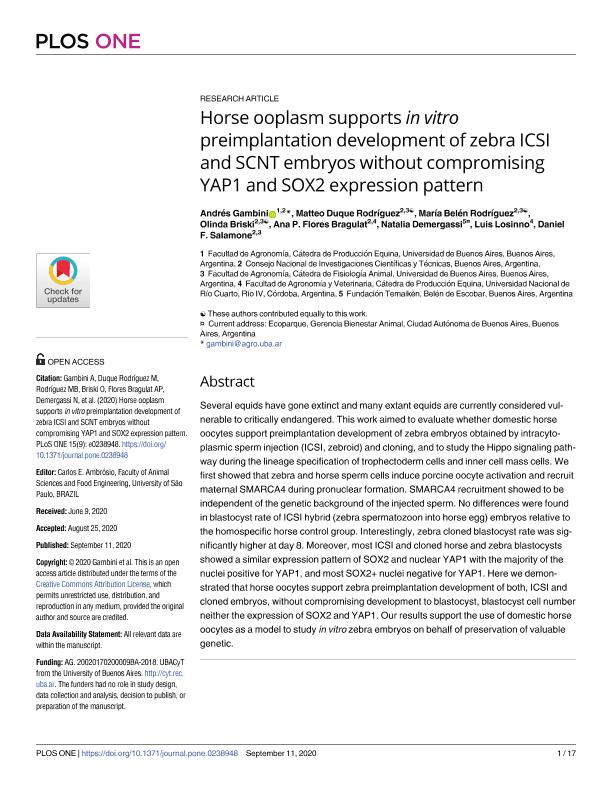Mostrar el registro sencillo del ítem
dc.contributor.author
Gambini, Andres

dc.contributor.author
Duque Rodriguez, Matteo

dc.contributor.author
Rodriguez, Maria Belén

dc.contributor.author
Briski, Olinda

dc.contributor.author
Flores Bragulat, Ana Paula

dc.contributor.author
Demergassi, Natalia
dc.contributor.author
Losinno, Luis

dc.contributor.author
Salamone, Daniel Felipe

dc.date.available
2021-03-18T20:40:39Z
dc.date.issued
2020-09-11
dc.identifier.citation
Gambini, Andres; Duque Rodriguez, Matteo; Rodriguez, Maria Belén; Briski, Olinda; Flores Bragulat, Ana Paula; et al.; Horse ooplasm supports in vitro preimplantation development of zebra ICSI and SCNT embryos without compromising YAP1 and SOX2 expression pattern; Public Library of Science; Plos One; 15; 9; 11-9-2020; 1-17
dc.identifier.issn
1932-6203
dc.identifier.uri
http://hdl.handle.net/11336/128596
dc.description.abstract
Several equids have gone extinct and many extant equids are currently considered vulnerable to critically endangered. This work aimed to evaluate whether domestic horse oocytes support preimplantation development of zebra embryos obtained by intracytoplasmic sperm injection (ICSI, zebroid) and cloning, and to study the Hippo signaling pathway during the lineage specification of trophectoderm cells and inner cell mass cells. We first showed that zebra and horse sperm cells induce porcine oocyte activation and recruit maternal SMARCA4 during pronuclear formation. SMARCA4 recruitment showed to be independent of the genetic background of the injected sperm. No differences were found in blastocyst rate of ICSI hybrid (zebra spermatozoon into horse egg) embryos relative to the homospecific horse control group. Interestingly, zebra cloned blastocyst rate was significantly higher at day 8. Moreover, most ICSI and cloned horse and zebra blastocysts showed a similar expression pattern of SOX2 and nuclear YAP1 with the majority of the nuclei positive for YAP1, and most SOX2+ nuclei negative for YAP1. Here we demonstrated that horse oocytes support zebra preimplantation development of both, ICSI and cloned embryos, without compromising development to blastocyst, blastocyst cell number neither the expression of SOX2 and YAP1. Our results support the use of domestic horse oocytes as a model to study in vitro zebra embryos on behalf of preservation of valuable genetic.
dc.format
application/pdf
dc.language.iso
eng
dc.publisher
Public Library of Science

dc.rights
info:eu-repo/semantics/openAccess
dc.rights.uri
https://creativecommons.org/licenses/by/2.5/ar/
dc.subject
Zebra
dc.subject
Cloning
dc.subject
Icsi
dc.subject
Oocyte
dc.subject.classification
Tecnología GM, clonación de ganado, selección asistida, diagnósticos, tecnología de producción de biomasa, etc.

dc.subject.classification
Biotecnología Agropecuaria

dc.subject.classification
CIENCIAS AGRÍCOLAS

dc.title
Horse ooplasm supports in vitro preimplantation development of zebra ICSI and SCNT embryos without compromising YAP1 and SOX2 expression pattern
dc.type
info:eu-repo/semantics/article
dc.type
info:ar-repo/semantics/artículo
dc.type
info:eu-repo/semantics/publishedVersion
dc.date.updated
2021-03-05T18:48:13Z
dc.journal.volume
15
dc.journal.number
9
dc.journal.pagination
1-17
dc.journal.pais
Estados Unidos

dc.journal.ciudad
San Francisco
dc.description.fil
Fil: Gambini, Andres. Consejo Nacional de Investigaciones Científicas y Técnicas; Argentina. Universidad de Buenos Aires. Facultad de Agronomía; Argentina
dc.description.fil
Fil: Duque Rodriguez, Matteo. Consejo Nacional de Investigaciones Científicas y Técnicas; Argentina. Universidad de Buenos Aires. Facultad de Agronomia. Departamento de Producción Animal. Cátedra de Fisiología Animal; Argentina
dc.description.fil
Fil: Rodriguez, Maria Belén. Consejo Nacional de Investigaciones Científicas y Técnicas; Argentina. Universidad de Buenos Aires. Facultad de Agronomia. Departamento de Producción Animal. Cátedra de Fisiología Animal; Argentina
dc.description.fil
Fil: Briski, Olinda. Consejo Nacional de Investigaciones Científicas y Técnicas; Argentina. Universidad de Buenos Aires. Facultad de Agronomia. Departamento de Producción Animal. Cátedra de Fisiología Animal; Argentina
dc.description.fil
Fil: Flores Bragulat, Ana Paula. Consejo Nacional de Investigaciones Científicas y Técnicas; Argentina. Universidad Nacional de Río Cuarto. Facultad de Agronomía y Veterinaria; Argentina
dc.description.fil
Fil: Demergassi, Natalia. Fundación Temaikén; Argentina
dc.description.fil
Fil: Losinno, Luis. Universidad Nacional de Río Cuarto. Facultad de Agronomía y Veterinaria; Argentina
dc.description.fil
Fil: Salamone, Daniel Felipe. Consejo Nacional de Investigaciones Científicas y Técnicas; Argentina. Universidad de Buenos Aires. Facultad de Agronomia. Departamento de Producción Animal. Cátedra de Fisiología Animal; Argentina
dc.journal.title
Plos One

dc.relation.alternativeid
info:eu-repo/semantics/altIdentifier/doi/http://dx.doi.org/10.1371/journal.pone.0238948
dc.relation.alternativeid
info:eu-repo/semantics/altIdentifier/url/https://dx.plos.org/10.1371/journal.pone.0238948
dc.relation.alternativeid
info:eu-repo/semantics/altIdentifier/url/https://www.ncbi.nlm.nih.gov/pmc/articles/PMC7485800/
Archivos asociados
